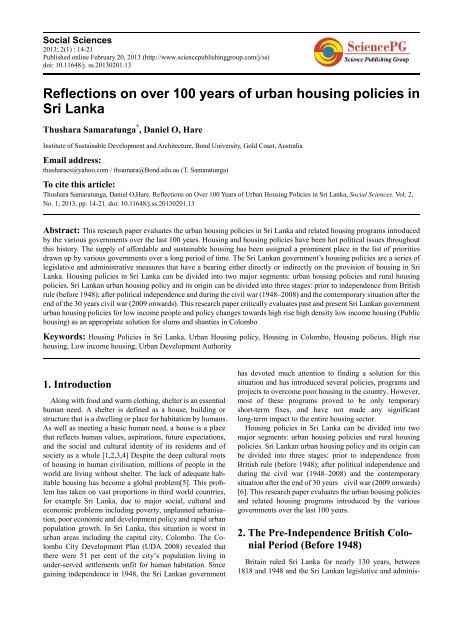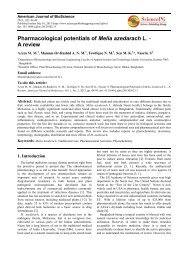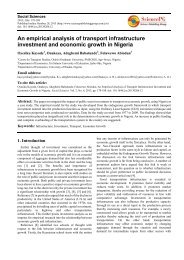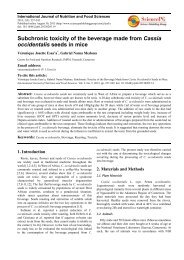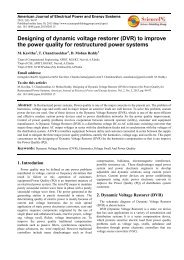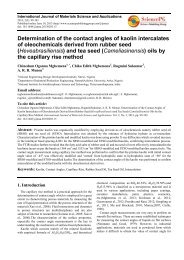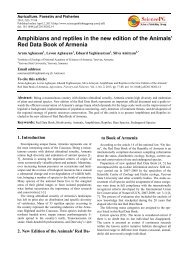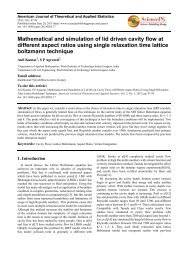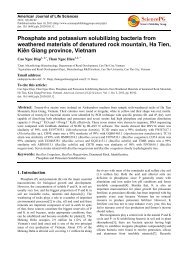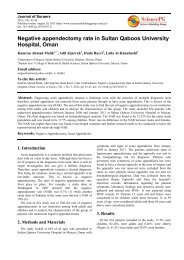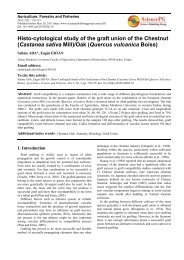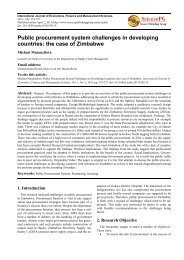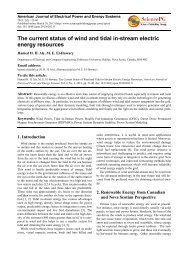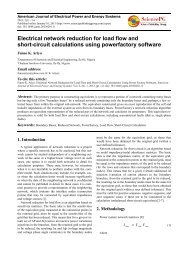Reflections on over 100 years of urban housing policies in Sri Lanka
Reflections on over 100 years of urban housing policies in Sri Lanka
Reflections on over 100 years of urban housing policies in Sri Lanka
Create successful ePaper yourself
Turn your PDF publications into a flip-book with our unique Google optimized e-Paper software.
16 Thushara Samaratunga et al.: <str<strong>on</strong>g>Reflecti<strong>on</strong>s</str<strong>on</strong>g> <strong>on</strong> <strong>over</strong> <strong>100</strong> <strong>years</strong> <strong>of</strong> <strong>urban</strong> <strong>hous<strong>in</strong>g</strong> <strong>policies</strong> <strong>in</strong> <strong>Sri</strong> <strong>Lanka</strong>dem<strong>on</strong>strates the clear <strong>in</strong>fluence <strong>of</strong> socialist political parties.It was <strong>in</strong>itially viewed as a positive and ‘pro-poor’ program,however the end result was the decl<strong>in</strong>e <strong>of</strong> private sector<strong>in</strong>vestment <strong>in</strong> <strong>hous<strong>in</strong>g</strong> supply. When Bandaranayakee’sg<strong>over</strong>nment lost power <strong>in</strong> 1976, the policy was withdrawn[12].Another important piece <strong>of</strong> legislati<strong>on</strong> that was enactedalmost parallel to the Apartment Ownership Law <strong>of</strong> 1973,was the Comm<strong>on</strong> Amenities Board Law No. 10 <strong>of</strong> 1973,which required the establishment <strong>of</strong> the Comm<strong>on</strong> AmenitiesBoard. The Comm<strong>on</strong> Amenities Board was empowered withresp<strong>on</strong>sibility to c<strong>on</strong>trol, manage, ma<strong>in</strong>ta<strong>in</strong> and adm<strong>in</strong>isterthe comm<strong>on</strong> amenities and comm<strong>on</strong> elements <strong>of</strong> residentialand n<strong>on</strong>-residential units <strong>of</strong> c<strong>on</strong>dom<strong>in</strong>ium properties [11].There were three ma<strong>in</strong> comp<strong>on</strong>ents <strong>of</strong> the g<strong>over</strong>nment’sprogram: the Aided Self-Help Hous<strong>in</strong>g; Model Villages; andFisheries Hous<strong>in</strong>g. The Aided Self-Help programme (ASH)was another creative <strong>hous<strong>in</strong>g</strong> program that was specificallytargeted to middle-class people. The ASH was <strong>in</strong>troduced <strong>in</strong>1972, and stated that the g<strong>over</strong>nment would meet the cost <strong>of</strong>the land, build<strong>in</strong>g materials and certa<strong>in</strong> necessary servicesrequired for a low-cost house while the buyer provided thelabour. An <strong>in</strong>terest free 20- to 25-year loan c<strong>over</strong>ed the cost<strong>of</strong> build<strong>in</strong>g materials, while a normal ground rent wascharged for the land. Model Villages and Fisheries Hous<strong>in</strong>gwere <strong>in</strong>tended almost exclusively for the rural poor. Thisapproach enabled the g<strong>over</strong>nment to effect c<strong>on</strong>siderablereducti<strong>on</strong>s <strong>in</strong> the cost <strong>of</strong> low-<strong>in</strong>come <strong>hous<strong>in</strong>g</strong> units andspread the benefits <strong>of</strong> public sector <strong>in</strong>vestment <strong>over</strong> a largernumber <strong>of</strong> beneficiaries. More importantly, these programsc<strong>on</strong>tributed to community participati<strong>on</strong> and c<strong>on</strong>sequently tocommunity development [13]5. Hous<strong>in</strong>g Policy (1977-1983)The 1970–1976 socialist political strategies were notpopular <strong>in</strong> <strong>Sri</strong> <strong>Lanka</strong> and many people were frustrated withthe radical decisi<strong>on</strong>s made by Bandaranayakee’s g<strong>over</strong>nment.The 1977 electi<strong>on</strong> was dom<strong>in</strong>ated by the United Nati<strong>on</strong>alParty, who w<strong>on</strong> with a 5/6 majority. Ec<strong>on</strong>omic reform,social welfare and <strong>hous<strong>in</strong>g</strong> were the key electi<strong>on</strong> promisesmade by the new g<strong>over</strong>nment and, as promised, open ec<strong>on</strong>omicpolicy was <strong>in</strong>troduced <strong>in</strong> 1978. The g<strong>over</strong>nment wasalso c<strong>on</strong>cerned about the provisi<strong>on</strong> <strong>of</strong> houses to the lowerand middle-<strong>in</strong>come groups <strong>in</strong> <strong>urban</strong> and rural areas.Ranas<strong>in</strong>ha Pramadasa was the Prime M<strong>in</strong>ister and Hous<strong>in</strong>gM<strong>in</strong>ister <strong>of</strong> the new g<strong>over</strong>nment dur<strong>in</strong>g this period. Headopted several outstand<strong>in</strong>g <strong>hous<strong>in</strong>g</strong> <strong>policies</strong> and projectsand undertook significant <strong>in</strong>stituti<strong>on</strong>al reform while he was<strong>in</strong> power. The popularity and success <strong>of</strong> the welfare <strong>policies</strong>implemented <strong>in</strong> this time paved the way for his electi<strong>on</strong> asPresident <strong>of</strong> <strong>Sri</strong> <strong>Lanka</strong> <strong>in</strong> 1989[10]. Dur<strong>in</strong>g this period,<strong>hous<strong>in</strong>g</strong> policy was not developed <strong>in</strong> isolati<strong>on</strong> - it took placewith<strong>in</strong> the c<strong>on</strong>text <strong>of</strong> <strong>over</strong>all city development [14]. Toachieve the target set by the g<strong>over</strong>nment, the Urban DevelopmentAuthority (UDA) and the Nati<strong>on</strong>al Hous<strong>in</strong>g DevelopmentAuthority (NHDA) were established <strong>in</strong> 1978 and1979 respectively. The programs implemented by the g<strong>over</strong>nmentdur<strong>in</strong>g its 17 <strong>years</strong> <strong>of</strong> power were the Hundred ThousandHouses Program (1978-1983), the Milli<strong>on</strong> Houses Program(1984-1989) and the 1.5 Milli<strong>on</strong> Houses Program(1989-1994). Ranas<strong>in</strong>ghe Premadasa understood that problemswith <strong>hous<strong>in</strong>g</strong> are a global issue, and proposed to theUnited Nati<strong>on</strong>s General Assembly <strong>in</strong> 1980 that 1987 bedeclared as the ‘Internati<strong>on</strong>al Year <strong>of</strong> Shelter for theHomeless’ [15].6. The Hundred Thousand Houses Program(1977–1983)The Hundred Thousand Houses Program was the first<strong>in</strong>itiative <strong>of</strong> the UNP G<strong>over</strong>nment. The newly establishedNati<strong>on</strong>al Hous<strong>in</strong>g Development Authority (NHDA) led theprogram. 50,000 houses were built <strong>in</strong> rural areas through theaided self-help method. Another 30,000 houses (<strong>in</strong>clud<strong>in</strong>ghigh-rises for the middle class) were built <strong>in</strong> <strong>urban</strong> areasthrough direct c<strong>on</strong>structi<strong>on</strong> by the private sector. The rema<strong>in</strong><strong>in</strong>ghouses were targeted at the <strong>urban</strong> poor <strong>in</strong> Colombothrough a slum and shanty upgrad<strong>in</strong>g comp<strong>on</strong>ent headed bythe Urban Development Authority (UDA). Follow<strong>in</strong>g thesuccess <strong>of</strong> the Hundred Thousand Houses Program, theg<strong>over</strong>nment <strong>in</strong>troduced the One Milli<strong>on</strong> Houses Program,hop<strong>in</strong>g the new expanded program would be even moresuccessful than the previous <strong>on</strong>e as it could draw from theexperience ga<strong>in</strong>ed <strong>in</strong> the development and c<strong>on</strong>structi<strong>on</strong> <strong>of</strong>the previous project [16].7. One Milli<strong>on</strong> Houses Program –“Hous<strong>in</strong>g For All” (1984-1989)In 1984, the G<strong>over</strong>nment <strong>in</strong>itiated the Milli<strong>on</strong> HousesProgram (MHP). The Nati<strong>on</strong>al Hous<strong>in</strong>g Development Authority(NHDA) was <strong>in</strong> charge <strong>of</strong> the massive nati<strong>on</strong>wideprogram. The program c<strong>on</strong>sisted <strong>of</strong> six sub-programs c<strong>over</strong><strong>in</strong>grural and <strong>urban</strong> areas, the private sector, plantati<strong>on</strong><strong>hous<strong>in</strong>g</strong> and major resettlement projects [16]. After the earlysuccess <strong>of</strong> the first rural <strong>hous<strong>in</strong>g</strong> sub-programme <strong>in</strong> 1984,the <strong>urban</strong> sub-programme, c<strong>on</strong>sist<strong>in</strong>g <strong>of</strong> about 300 <strong>hous<strong>in</strong>g</strong>projects <strong>in</strong> 51 local authority areas, was launched <strong>in</strong> 1985.The MHP was notable because all the procedural mechanismswere completely <strong>in</strong>stituti<strong>on</strong>alised by the g<strong>over</strong>nment<strong>of</strong> <strong>Sri</strong> <strong>Lanka</strong> through a nati<strong>on</strong>al policy. The nati<strong>on</strong>alpolicy encouraged the local g<strong>over</strong>nments, community organisati<strong>on</strong>sand the beneficiary groups to make decisi<strong>on</strong>sregard<strong>in</strong>g the <strong>hous<strong>in</strong>g</strong> development at their respective levels(NHDA 1984). A ma<strong>in</strong> feature <strong>of</strong> the MHP was the m<strong>in</strong>imum<strong>in</strong>terventi<strong>on</strong> and maximum support provided by theg<strong>over</strong>nment and maximum <strong>in</strong>volvement <strong>of</strong> the builder families[16]. The Urban Development Authority (UDA),meanwhile, carried out an <strong>urban</strong> slum and shanty upgrad<strong>in</strong>gprogram.The MHP was an important <strong>in</strong>itiative because it was acommunity-centred, participatory <strong>hous<strong>in</strong>g</strong> program admi-
Social Sciences 2013, 2(1): 14-21 17nistered by local authorities and supported by nati<strong>on</strong>al <strong>in</strong>stituti<strong>on</strong>s.As the MHP res<strong>on</strong>ated deeply with the prevail<strong>in</strong>gWorld Bank and UN-Habitat ideology <strong>of</strong> ‘enabl<strong>in</strong>g’ growthand markets, it is <strong>of</strong>ten referred to as a ‘best practice’ methodthat should be to be emulated by other countries [13]. At asem<strong>in</strong>ar organised by the Pr<strong>of</strong>essi<strong>on</strong>al Associati<strong>on</strong> <strong>of</strong> <strong>Sri</strong><strong>Lanka</strong> (OPSSL) which was held <strong>in</strong> Colombo <strong>in</strong> 1990,President <strong>of</strong> <strong>Sri</strong> <strong>Lanka</strong> Pramadasa stated about the MHP:The role <strong>of</strong> the state is as a supporter, guide and m<strong>on</strong>itor <strong>of</strong>poor communities. All decid<strong>in</strong>g and do<strong>in</strong>g is d<strong>on</strong>e by thepoor communities themselves. The poor family-the poorcommunities are at the very centre <strong>of</strong> their ownself-development process. The poor are the subjects. Andg<strong>over</strong>nment supports their <strong>in</strong>itiative and <strong>in</strong>tervenes <strong>on</strong>ly <strong>in</strong>matters and areas where they cannot solve problems <strong>on</strong> theirown [15]The MHP was made up <strong>of</strong> six sub-programs, <strong>in</strong>clud<strong>in</strong>gtwo that were implemented by the Nati<strong>on</strong>al Hous<strong>in</strong>g DevelopmentAuthority (NHDA): the Urban Hous<strong>in</strong>gSub-Program (UHSP) and the Rural Hous<strong>in</strong>g Sub-Program(RHSP). The rema<strong>in</strong><strong>in</strong>g four sub-programs were implementedby other <strong>in</strong>stituti<strong>on</strong>s: the Private Sector (Formal)Hous<strong>in</strong>g Sub-Program (PSFHSP); the Private Sector (Informal)Hous<strong>in</strong>g Sub-Program (PIHSP); the Plantati<strong>on</strong>Hous<strong>in</strong>g Sub-Program (PHSP); and the Mahaweli Hous<strong>in</strong>gSub-Program (MHSP) [15]. Fund<strong>in</strong>g for the MHP wasgenerated through the nati<strong>on</strong>al budget, foreign grants and the<strong>in</strong>come from the Hous<strong>in</strong>g Lottery.8. The 1.5 Milli<strong>on</strong> Houses Program(1990-1995)After the success <strong>of</strong> the One Milli<strong>on</strong> Houses program, theg<strong>over</strong>nment <strong>in</strong>troduced the 1.5 Milli<strong>on</strong> Houses Program <strong>in</strong>1990. However, there has been much criticism about theactual number <strong>of</strong> houses which were c<strong>on</strong>structed under theOne Milli<strong>on</strong> Houses Program [17]. Regardless <strong>of</strong> exactlyhow many houses were actually c<strong>on</strong>structed, a significantnumber <strong>of</strong> houses were built dur<strong>in</strong>g that program. The approach<strong>of</strong> the 1.5 Milli<strong>on</strong> Houses Program was slightlydifferent from the One Milli<strong>on</strong> Houses program as it addressed<strong>hous<strong>in</strong>g</strong> issues across all levels <strong>of</strong> society. Therewere eight sub-programs [15]: the Urban Hous<strong>in</strong>gSub-Program (UHSP); the Rural Hous<strong>in</strong>g Sub-Program(RHSP); the Disaster Hous<strong>in</strong>g Sub-Program (DHSP); the Prov<strong>in</strong>cialCouncil Hous<strong>in</strong>g Sub-Program (PCHSP); the MahaweliHous<strong>in</strong>g Sub-Program (MHSP) (MSP); the Plantati<strong>on</strong> Hous<strong>in</strong>gSub-Program (PHSP); the Employee Hous<strong>in</strong>g Sub-Program(EHSP); and the Individual Family Hous<strong>in</strong>g[15].Between 1978 and 1993, the UNP G<strong>over</strong>nment <strong>in</strong>vestedmany milli<strong>on</strong> rupees <strong>on</strong> <strong>hous<strong>in</strong>g</strong> programs <strong>in</strong> the country.The ma<strong>in</strong> fund<strong>in</strong>g mechanism for these programs wastreasury grants, foreign aid and Hous<strong>in</strong>g Lottery <strong>in</strong>come(Sevana Lottery) which was run by the M<strong>in</strong>istry <strong>of</strong> Hous<strong>in</strong>g.The Hous<strong>in</strong>g Lottery paid approximately 400 to 500 milli<strong>on</strong>rupees per annum to the Sevana Fund, which provided directassistance to low-<strong>in</strong>come households [6].9. Compact City Development(1994-2005)In 1994 the People’s Alliance (PA) G<strong>over</strong>nment w<strong>on</strong>power after 17 <strong>years</strong> <strong>of</strong> dom<strong>in</strong>ati<strong>on</strong> by the United Nati<strong>on</strong>alParty. Under the new g<strong>over</strong>nment, <strong>hous<strong>in</strong>g</strong> <strong>policies</strong> took anew directi<strong>on</strong> and <strong>in</strong>stituti<strong>on</strong>al reform and pr<strong>of</strong>essi<strong>on</strong>al<strong>in</strong>volvement significantly improved. The g<strong>over</strong>nment reformulated<strong>hous<strong>in</strong>g</strong> <strong>policies</strong> and created legal and <strong>in</strong>stituti<strong>on</strong>alc<strong>on</strong>diti<strong>on</strong>s more favourable for private and g<strong>over</strong>nmentsector <strong>in</strong>volvement <strong>in</strong> <strong>hous<strong>in</strong>g</strong> development. The major<strong>hous<strong>in</strong>g</strong> <strong>policies</strong> <strong>in</strong> this period were the provisi<strong>on</strong> <strong>of</strong> morehouses <strong>in</strong> <strong>urban</strong> areas and a qualitative improvement <strong>in</strong>rural/estate houses [6].The Presidential Task Force <strong>on</strong> Hous<strong>in</strong>g and Urban Developmentwas appo<strong>in</strong>ted <strong>in</strong> 1998 to draw up a macro-policyframework and an acti<strong>on</strong> program for both theshort and l<strong>on</strong>g-term physical development <strong>of</strong> <strong>Sri</strong> <strong>Lanka</strong>,with a view to improv<strong>in</strong>g the quality <strong>of</strong> life <strong>of</strong> its <strong>in</strong>habitantsand meet<strong>in</strong>g the aspirati<strong>on</strong> <strong>of</strong> a modern 21st Centurycity[17].The task force made an important recommendati<strong>on</strong> to theg<strong>over</strong>nment <strong>of</strong> <strong>Sri</strong> <strong>Lanka</strong> and the M<strong>in</strong>istry <strong>of</strong> Urban Development,C<strong>on</strong>structi<strong>on</strong> and Public Utilities that a newcompany named Real Estate Exchange (Pvt) Limited(REEL) should be established. This company is fullyowned by g<strong>over</strong>nment and its ma<strong>in</strong> shareholders are theUrban Development Authority (UDA), the Nati<strong>on</strong>al Hous<strong>in</strong>gDevelopment Authority (NHDA), the <strong>Sri</strong> <strong>Lanka</strong> LandReclamati<strong>on</strong> and Development Corporati<strong>on</strong> (SLLR&DC)and the Colombo Municipal Council (CMC). The motto <strong>of</strong>REEL is simple: “Homes for people and lands for development”.The operati<strong>on</strong>al arm <strong>of</strong> REEL is the Susta<strong>in</strong>ableTownship Programme (STP), which was also established <strong>in</strong>1998. It has been work<strong>in</strong>g <strong>in</strong> the city <strong>of</strong> Colombo by promot<strong>in</strong>ghigh-density <strong>hous<strong>in</strong>g</strong> with<strong>in</strong> a broad <strong>urban</strong> plann<strong>in</strong>gand development framework. This program aims tore-house those families who are encumbered with no titles<strong>on</strong> the valuable lands with<strong>in</strong> the city <strong>of</strong> Colombo <strong>in</strong> moderncompact townships, and liberate those lands for <strong>urban</strong> redevelopment[17].The ma<strong>in</strong> functi<strong>on</strong>s <strong>of</strong> REEL are to issue securitiesaga<strong>in</strong>st prime lands <strong>in</strong> Colombo and to create a sec<strong>on</strong>dary<strong>hous<strong>in</strong>g</strong> market and sec<strong>on</strong>dary mortgage <strong>in</strong>struments.REEL also promotes private public sector partnership <strong>in</strong>real estate and <strong>urban</strong> renewal and development. REEL <strong>of</strong>fersa low-cost, market-based soluti<strong>on</strong> for re-<strong>hous<strong>in</strong>g</strong> poorhouseholders <strong>in</strong> Colombo and <strong>of</strong>fers <strong>in</strong>centives to <strong>in</strong>vestorsto participate <strong>in</strong> mortgage and f<strong>in</strong>anc<strong>in</strong>g, <strong>hous<strong>in</strong>g</strong> and <strong>in</strong>frastructurec<strong>on</strong>diti<strong>on</strong>s and <strong>urban</strong> renewal and development. Itis expected to change the outdated laws perta<strong>in</strong><strong>in</strong>g to <strong>hous<strong>in</strong>g</strong>and real estate development when and where necessary.9.1. The REEL Process
18 Thushara Samaratunga et al.: <str<strong>on</strong>g>Reflecti<strong>on</strong>s</str<strong>on</strong>g> <strong>on</strong> <strong>over</strong> <strong>100</strong> <strong>years</strong> <strong>of</strong> <strong>urban</strong> <strong>hous<strong>in</strong>g</strong> <strong>policies</strong> <strong>in</strong> <strong>Sri</strong> <strong>Lanka</strong>A field survey c<strong>on</strong>ducted by Real Estate Exchange (Pvt)Limited (REEL) <strong>in</strong> 1999 revealed that there were 1,506poorly served settlements the city <strong>of</strong> Colombo, which c<strong>on</strong>ta<strong>in</strong>edapproximately 66,000 <strong>urban</strong> low-<strong>in</strong>come householders.These 66,000 householders occupied nearly 300 hectares<strong>of</strong> land area [17]. About 70 per cent <strong>of</strong> these under-utilisedland parcels existed <strong>in</strong> strategic locati<strong>on</strong>s whereland value is comparatively high. Most <strong>of</strong> the land wasstate-owned but state entities could not realise the value <strong>of</strong>their lands due to heavy encumbrances. The clearance <strong>of</strong>encumbrances and creati<strong>on</strong> <strong>of</strong> small-hold<strong>in</strong>gs can greatlyimpact <strong>urban</strong> development <strong>in</strong> Colombo and it was hopedthat liberat<strong>in</strong>g these lands would play a key role <strong>in</strong> chang<strong>in</strong>gColombo’s land use as planned out by the ColomboDevelopment Plan and the Colombo Metropolitan Regi<strong>on</strong>alStructure Plan CMRSP [2].REEL proposed to liberate 70 per cent <strong>of</strong> encumberedlands and dispose them <strong>in</strong> a public market for alternativeuses. The <strong>in</strong>come realised through this disposal would beallocated for the c<strong>on</strong>structi<strong>on</strong> <strong>of</strong> high-density <strong>hous<strong>in</strong>g</strong> <strong>in</strong> thebalance lands. Thus, the standard houses c<strong>on</strong>structedthrough the build<strong>in</strong>g <strong>in</strong>dustry for this program are givenfree to the affected household, respective <strong>of</strong> their previousownership status. It is a house-to-house exchange process.The benefits for this plan would work two ways: the beneficiaryfamily can enjoy a brand-new standard apartmentwhile the STP is able to provide prime lands for guided<strong>urban</strong> development.The Susta<strong>in</strong>able Township Program (STP) is add<strong>in</strong>gstandard houses to the nati<strong>on</strong>al <strong>hous<strong>in</strong>g</strong> stock without costto the state g<strong>over</strong>nment. The effect <strong>of</strong> employment generati<strong>on</strong>though the build<strong>in</strong>g <strong>in</strong>dustry is significant and its c<strong>on</strong>tributi<strong>on</strong>to the productivity <strong>of</strong> the city labor force is c<strong>on</strong>siderable.Thisprogram was a market-based, self-f<strong>in</strong>ancedproperty development strategy rather than that <strong>of</strong> astate-sp<strong>on</strong>sored, aid-led, c<strong>on</strong>venti<strong>on</strong>al strategy [18].10. The ‘Mah<strong>in</strong>da Ch<strong>in</strong>thana’ Program(2005-2010)The 2005 electi<strong>on</strong> was w<strong>on</strong> by the same rul<strong>in</strong>g partywhich had held power s<strong>in</strong>ce 1994, and a new president,Mah<strong>in</strong>da Rajapaksa, was elected. His electi<strong>on</strong> manifesto‘Mah<strong>in</strong>da Ch<strong>in</strong>thanaya’ categorically stated that "Everyfamily <strong>in</strong> <strong>Sri</strong> <strong>Lanka</strong> should own a house" (UPFA 2005). TheJana Sevana <strong>hous<strong>in</strong>g</strong> program was <strong>in</strong> l<strong>in</strong>e with the ‘Mah<strong>in</strong>daCh<strong>in</strong>thana’ visi<strong>on</strong>, under the supervisi<strong>on</strong> <strong>of</strong> PresidentMub<strong>in</strong>da Rajapaksa. Several sub-programs have been implementedunder this project, and under <strong>on</strong>e sub-program,1,000 selected families received a 500,000-rupee loan to c<strong>on</strong>structtheir houses and another 1,000 low-<strong>in</strong>come families weregranted <strong>hous<strong>in</strong>g</strong> loans up to a maximum <strong>100</strong>,000 rupees [20].Also, the “Diriya Piyasa” <strong>hous<strong>in</strong>g</strong> program, implemented bythe <strong>Sri</strong> <strong>Lanka</strong> Samurdhi Authority (SLSA) had c<strong>on</strong>structed5,000 houses <strong>in</strong> 2005, provid<strong>in</strong>g a last–ditch soluti<strong>on</strong> to theacute shelter problem <strong>of</strong> low-<strong>in</strong>come families [20].There were several g<strong>over</strong>nment <strong>in</strong>stituti<strong>on</strong>s engaged <strong>in</strong>facilitat<strong>in</strong>g the development <strong>of</strong> groups targeted for <strong>hous<strong>in</strong>g</strong>support. The Nati<strong>on</strong>al Hous<strong>in</strong>g Development Authority(NHDA) was the primary public sector <strong>in</strong>stituti<strong>on</strong> c<strong>on</strong>cernedwith implement<strong>in</strong>g <strong>hous<strong>in</strong>g</strong> programs. The NHDA had <strong>in</strong>troducedseveral <strong>hous<strong>in</strong>g</strong> programs especially for the targetedlow-<strong>in</strong>come households. Under the various <strong>hous<strong>in</strong>g</strong>development programs, the NHDA completed 46,021<strong>hous<strong>in</strong>g</strong> units the various <strong>hous<strong>in</strong>g</strong> development programs.The Real Estate Exchange (PVT) Ltd. (REEL), is alsoplann<strong>in</strong>g to improve, the liv<strong>in</strong>g standards <strong>of</strong> the approximately66,000 shanty dwellers <strong>in</strong> <strong>urban</strong> centres by provid<strong>in</strong>gthem with better <strong>hous<strong>in</strong>g</strong> and other <strong>in</strong>frastructure and facilities<strong>over</strong> the next 10 <strong>years</strong> [20]. The UDA has undertakenthe relocati<strong>on</strong> <strong>of</strong> dwellers <strong>in</strong> unauthorised slums and shanties<strong>in</strong> the project areas which have been identified as essentialfor city development.Under President Mah<strong>in</strong>da Rajapaksa's l<strong>on</strong>g-term <strong>hous<strong>in</strong>g</strong>development policy, as outl<strong>in</strong>ed <strong>in</strong> the 'Ten-Year Visi<strong>on</strong>' andthe 'Jana Sevana One Milli<strong>on</strong> Houses Program', theTen-Year Horiz<strong>on</strong> Development Framework was issued <strong>in</strong>November 2006. This is a broad policy framework c<strong>on</strong>sistentwith the ‘Mah<strong>in</strong>da Ch<strong>in</strong>thana’ Program, and it envisagesa plan to meet a large part <strong>of</strong> the grow<strong>in</strong>g demand for houses<strong>in</strong> <strong>Sri</strong> <strong>Lanka</strong>[21]. The policy aims to ensure the plannedhuman settlements take <strong>in</strong>to c<strong>on</strong>siderati<strong>on</strong> populati<strong>on</strong> density,land suitability and envir<strong>on</strong>mental susta<strong>in</strong>ability. The<strong>hous<strong>in</strong>g</strong> policy also c<strong>on</strong>sists <strong>of</strong> the adopti<strong>on</strong> <strong>of</strong> the verticaldevelopment approaches <strong>in</strong> high and medium density areas,implementati<strong>on</strong> <strong>of</strong> participatory approaches wherever possible,develop<strong>in</strong>g the <strong>hous<strong>in</strong>g</strong> f<strong>in</strong>ance market with primaryand sec<strong>on</strong>dary mortgage f<strong>in</strong>anc<strong>in</strong>g facilities and provid<strong>in</strong>gg<strong>over</strong>nment assistance for needy groups [21].The “Arunodaya” Urban Poor Hous<strong>in</strong>g Program was anotherlow-<strong>in</strong>come <strong>hous<strong>in</strong>g</strong> project implemented by the Rajapaksag<strong>over</strong>nment. It was run by the M<strong>in</strong>istry <strong>of</strong> UrbanDevelopment and Sacred Area Development. The M<strong>in</strong>istry<strong>of</strong> Urban Development was resp<strong>on</strong>sible for slum and shantyrelocati<strong>on</strong> with the aim <strong>of</strong> implement<strong>in</strong>g the present g<strong>over</strong>nment’spolicy ‘Mah<strong>in</strong>da Ch<strong>in</strong>thanaya’ with susta<strong>in</strong>able<strong>urban</strong> development. This program was funded without allocati<strong>on</strong>sfrom the C<strong>on</strong>solidated Fund <strong>of</strong> the G<strong>over</strong>nmentharnessed through the regulatory provisi<strong>on</strong>s made under theUDA law. Lack <strong>of</strong> funds is the ma<strong>in</strong> c<strong>on</strong>stra<strong>in</strong>t <strong>in</strong> this k<strong>in</strong>d <strong>of</strong>subsidised affordable <strong>hous<strong>in</strong>g</strong> program. However, this programcould create an avenue for revenue and then obta<strong>in</strong>sufficient funds without any difficulty. The ma<strong>in</strong> fund<strong>in</strong>gsource would be a service charge <strong>of</strong> 1% levied as the estimatedcost <strong>of</strong> c<strong>on</strong>structi<strong>on</strong> <strong>of</strong> build<strong>in</strong>gs exceed<strong>in</strong>g 5000square feet <strong>in</strong> floor area for the issue <strong>of</strong> Development Permit.However, the program was carried out solely based <strong>on</strong> <strong>in</strong>itiativesand drives <strong>of</strong> organised slum and shanty dwellersand local level leadership with the specific <strong>in</strong>itiatives, drivesand practices <strong>of</strong> shanty and slum dwellers to be accommodated<strong>in</strong> a clear framework methodology [12].The <strong>in</strong>volvement <strong>of</strong> slum and shanties communities <strong>in</strong> theplann<strong>in</strong>g and development <strong>of</strong> <strong>urban</strong> low-<strong>in</strong>come <strong>hous<strong>in</strong>g</strong>
Social Sciences 2013, 2(1): 14-21 19<strong>in</strong>creased <strong>in</strong> this period. The Urban Hous<strong>in</strong>g DevelopmentAuthority (UHDA) was established <strong>in</strong> 2009 for deal<strong>in</strong>g withthe <strong>urban</strong> <strong>hous<strong>in</strong>g</strong> issues. Although the new authority wasdeveloped with good <strong>in</strong>tenti<strong>on</strong>s, it did not succeed as expected,and at present the UHDA is a redundant organisati<strong>on</strong>attached to the M<strong>in</strong>istry <strong>of</strong> Hous<strong>in</strong>g.11. 2009 Onward - Relocati<strong>on</strong> <strong>of</strong> theUnder-served Settlement ProgramThe civil war <strong>in</strong> <strong>Sri</strong> <strong>Lanka</strong> ended <strong>in</strong> 2009. In 2010, PresidentMah<strong>in</strong>da Rajapaksa w<strong>on</strong> another extensi<strong>on</strong> <strong>of</strong> hispresidency with a huge majority. As a resp<strong>on</strong>se to the end <strong>of</strong>30 <strong>years</strong> <strong>of</strong> civil unrest, the g<strong>over</strong>nment’s priorities andpolitical agendas have shifted from military and defence to afocus <strong>on</strong> the ec<strong>on</strong>omic boom and the <strong>over</strong>all well-be<strong>in</strong>g <strong>of</strong>the country. The 30-year civil war resulted <strong>in</strong> huge ec<strong>on</strong>omicdamage to Colombo as the commercial capital <strong>of</strong> the country.The c<strong>on</strong>structi<strong>on</strong> <strong>in</strong>dustry was totally paralysed dur<strong>in</strong>g thatperiod, which greatly discouraged the c<strong>on</strong>structi<strong>on</strong> <strong>of</strong>high-rise low-<strong>in</strong>come projects <strong>in</strong> the city, as high-risebuild<strong>in</strong>gs were seen as easy targets for terrorists [21]. Apeaceful envir<strong>on</strong>ment and political stability have providedthe right envir<strong>on</strong>ment for radical policy decisi<strong>on</strong>s, especially<strong>in</strong> regards to <strong>hous<strong>in</strong>g</strong> and s<strong>in</strong>ce the g<strong>over</strong>nment has made theec<strong>on</strong>omic development <strong>of</strong> the country a priority. The politicalslogan <strong>of</strong> the Rajapaksa g<strong>over</strong>nment is “The miracle <strong>of</strong>South Asia” [22]. The gateway <strong>of</strong> that miracle is Colomboport, but the extensive number <strong>of</strong> slums and shanties that arelocated <strong>in</strong> that area are <strong>on</strong>e <strong>of</strong> the ma<strong>in</strong> challenges forachiev<strong>in</strong>g their goals. Most <strong>of</strong> the under-served settlementshave historically encroached <strong>on</strong> g<strong>over</strong>nment-owned primelands <strong>in</strong> the city, provid<strong>in</strong>g another barrier discourag<strong>in</strong>gforeign and local <strong>in</strong>vestment <strong>in</strong> to the city. C<strong>on</strong>sider<strong>in</strong>g all <strong>of</strong>these factors, the g<strong>over</strong>nment decided to take immediateacti<strong>on</strong> <strong>in</strong> re-<strong>hous<strong>in</strong>g</strong> under-served settlements <strong>in</strong> Colombo,and best opti<strong>on</strong> chosen to do this was to refocus <strong>on</strong> thecompact city c<strong>on</strong>cept which had been <strong>in</strong>troduced <strong>in</strong> 2000.The relocati<strong>on</strong> <strong>of</strong> under-served settlement project, alsocalled the 66,000 Low-Income Hous<strong>in</strong>g Project, was thema<strong>in</strong> program for address<strong>in</strong>g under-served settlements <strong>in</strong>Colombo. C<strong>on</strong>sider<strong>in</strong>g the priority and urgency <strong>of</strong> the outcome,this project is supervised by the president Mih<strong>in</strong>daRajapaksa directly and co-ord<strong>in</strong>ated by the Secretary <strong>of</strong>Defence, Gotabaya Rajapaksa. All logistic, plann<strong>in</strong>g andimplementati<strong>on</strong> work was the resp<strong>on</strong>sibility <strong>of</strong> the UrbanDevelopment Authority as a top priority project [18].Land exchange is the ma<strong>in</strong> fund<strong>in</strong>g mechanism for thisproject. More than 300 hectares <strong>of</strong> land has been illegallyencroached up<strong>on</strong> by the low-<strong>in</strong>come people <strong>in</strong> Colombo andthe strategy <strong>of</strong> the g<strong>over</strong>nment was to release two-thirds <strong>of</strong>this land (approximately 200 hectares) for sale <strong>on</strong> the openmarket. Initial capital was generated by issu<strong>in</strong>g debentures<strong>on</strong> the open market and 8.2 billi<strong>on</strong> rupees were receivedwith<strong>in</strong> four days <strong>of</strong> open<strong>in</strong>g the <strong>in</strong>itial public <strong>of</strong>fer<strong>in</strong>g <strong>on</strong> 24September 2010 [23]. The debentures will also be listed <strong>on</strong>the Colombo Stock Exchange (CSE). The 66,000 Hous<strong>in</strong>gProject is a two-way process, and its slogan “Houses forPeople and Land for Investment” reflects this. Unlike previousg<strong>over</strong>nment <strong>in</strong>itiatives, this is not solely a <strong>hous<strong>in</strong>g</strong> orshanty upgrad<strong>in</strong>g project [23].The prospectus for debentures states that the UDA ishop<strong>in</strong>g to f<strong>in</strong>ance the c<strong>on</strong>structi<strong>on</strong> <strong>of</strong> nearly 30,000 <strong>hous<strong>in</strong>g</strong>units as an <strong>in</strong>itial move to relocate part <strong>of</strong> the under-servedsettlements <strong>in</strong> and around Colombo, which is currently believedto house nearly 66,000 families [23] . The total estimatedcost for the c<strong>on</strong>structi<strong>on</strong> <strong>of</strong> all 66,000 <strong>hous<strong>in</strong>g</strong> units is132 billi<strong>on</strong> rupees, with each unit valued at two milli<strong>on</strong>rupees [23]. Nihal Fenando, Director General <strong>of</strong> the UDA,stated that that “Phase One c<strong>on</strong>structi<strong>on</strong> <strong>of</strong> 12,500 <strong>hous<strong>in</strong>g</strong>units as high-rise apartments will be implemented with<strong>in</strong>2011 as a priority”[23]. He added that “[the] phased outrelocati<strong>on</strong> programme is expected to be completed with<strong>in</strong>three <strong>years</strong>. Proposed Hous<strong>in</strong>g Units will be allocated to thetarget segment <strong>on</strong> an out right basis for a nom<strong>in</strong>al value”[18].Phase <strong>on</strong>e <strong>of</strong> the program is expected to liberate 150 acres<strong>of</strong> land with<strong>in</strong> Colombo city, with an estimated 25 billi<strong>on</strong>rupees to be raised by releas<strong>in</strong>g around 75 to 80 acres <strong>of</strong>liberated lands to prospective <strong>in</strong>vestors <strong>on</strong> l<strong>on</strong>g-term leasebasis [23].Surath Wickramas<strong>in</strong>ghe, the President <strong>of</strong> the Chamber <strong>of</strong>C<strong>on</strong>structi<strong>on</strong> Industry <strong>in</strong> <strong>Sri</strong> <strong>Lanka</strong>, stated:We must commend the G<strong>over</strong>nment and the DefenceM<strong>in</strong>istry <strong>in</strong> particular for embark<strong>in</strong>g <strong>on</strong> a challeng<strong>in</strong>g projectto relocate 60,000-70,000 <strong>hous<strong>in</strong>g</strong> units <strong>in</strong> under-servedsettlements occupy<strong>in</strong>g prime land <strong>in</strong> the City Colombo” [18]He further stated that he expected that after the relocati<strong>on</strong>there would be more than 1,000 acres <strong>of</strong> liberated land <strong>in</strong>the city <strong>of</strong> Colombo that will pave the way for the development<strong>of</strong> a “world-class” city with <strong>in</strong>tegratedstate-<strong>of</strong>-the-art <strong>in</strong>frastructure that would attract lead<strong>in</strong>g<strong>in</strong>vestors and developers and be competitive with otherAsian develop<strong>in</strong>g countries, like S<strong>in</strong>gapore [18]. This wouldtrigger growth <strong>in</strong> foreign and local bus<strong>in</strong>esses with all otherservices also expected to flourish and further develop thecity. To be successful, this c<strong>on</strong>cept must be supported by af<strong>in</strong>ancial and bus<strong>in</strong>ess hub that c<strong>on</strong>ta<strong>in</strong>s enterta<strong>in</strong>ment andshopp<strong>in</strong>g; culture, arts, exhibiti<strong>on</strong>s and festivals; knowledgeand multimedia technology; greenery, open spaces andplaygrounds; and modern, smart and susta<strong>in</strong>able <strong>hous<strong>in</strong>g</strong>.12. Hous<strong>in</strong>g Policies for High-RiseHous<strong>in</strong>gThe multi-storied <strong>hous<strong>in</strong>g</strong> c<strong>on</strong>cept was <strong>in</strong>troduced to <strong>Sri</strong><strong>Lanka</strong> <strong>in</strong> the 1950s by Sirimavo Bandaranayake’s g<strong>over</strong>nment.It was believed this type <strong>of</strong> <strong>hous<strong>in</strong>g</strong> was suitable formost flats c<strong>on</strong>structed for low and middle-class families andit was a new type <strong>of</strong> <strong>hous<strong>in</strong>g</strong> for most <strong>of</strong> the <strong>urban</strong> populati<strong>on</strong><strong>of</strong> Colombo. Almost all <strong>of</strong> the multi-storied <strong>hous<strong>in</strong>g</strong>complexes that were built at this time had a maximum height
20 Thushara Samaratunga et al.: <str<strong>on</strong>g>Reflecti<strong>on</strong>s</str<strong>on</strong>g> <strong>on</strong> <strong>over</strong> <strong>100</strong> <strong>years</strong> <strong>of</strong> <strong>urban</strong> <strong>hous<strong>in</strong>g</strong> <strong>policies</strong> <strong>in</strong> <strong>Sri</strong> <strong>Lanka</strong><strong>of</strong> five storeys, with most <strong>of</strong> them be<strong>in</strong>g four-level (groundplus three levels) compact <strong>hous<strong>in</strong>g</strong> units. However, it takestime for people to adapt to new types <strong>of</strong> <strong>hous<strong>in</strong>g</strong>, and due tolack <strong>of</strong> experience liv<strong>in</strong>g <strong>in</strong> this k<strong>in</strong>d <strong>of</strong> <strong>hous<strong>in</strong>g</strong>, people haddifficulties liv<strong>in</strong>g there generally get straggle <strong>in</strong> the beg<strong>in</strong>n<strong>in</strong>g[6]The first legislati<strong>on</strong> related to high-rise developments <strong>in</strong><strong>Sri</strong> <strong>Lanka</strong> was the C<strong>on</strong>dom<strong>in</strong>ium Property Act No. 12 <strong>of</strong>1970, which was a formal statement <strong>of</strong> the <strong>hous<strong>in</strong>g</strong> <strong>policies</strong><strong>of</strong> the then g<strong>over</strong>nment. The g<strong>over</strong>nment was very c<strong>on</strong>cernedabout the households who were rent<strong>in</strong>g <strong>in</strong> high-risebuild<strong>in</strong>gs and wanted to make them the owners <strong>of</strong> theirapartments. The c<strong>on</strong>structi<strong>on</strong> <strong>of</strong> large-scale multi-storiedbuild<strong>in</strong>gs <strong>in</strong> <strong>Sri</strong> <strong>Lanka</strong> started with the <strong>in</strong>troducti<strong>on</strong> <strong>of</strong> theApartment Ownership Law No. 11 <strong>of</strong> 1973. Before 1973, tosubdivide <strong>of</strong> a multi-storey build<strong>in</strong>g and then transfer part<strong>of</strong> the ownership <strong>of</strong> the build<strong>in</strong>g was very difficult andcomplicated. This law provided opportunities to divide amulti-storey <strong>hous<strong>in</strong>g</strong> complex <strong>in</strong>to a number <strong>of</strong> <strong>in</strong>dependentdwell<strong>in</strong>g units which would then c<strong>on</strong>t<strong>in</strong>ue under separateownership. The apartment ownership law was amended bythe C<strong>on</strong>dom<strong>in</strong>ium Act No. 45 <strong>of</strong> 1982. This Act def<strong>in</strong>es ac<strong>on</strong>dom<strong>in</strong>ium as: an <strong>in</strong>dependent unit <strong>in</strong> a c<strong>on</strong>dom<strong>in</strong>iumplan which is designed for <strong>in</strong>dependent use c<strong>on</strong>sist<strong>in</strong>g <strong>of</strong> <strong>on</strong>eor more rooms whether occupy<strong>in</strong>g the entire or part <strong>of</strong> <strong>on</strong>e ormore storey and which is shown as a separate unit <strong>in</strong> ac<strong>on</strong>dom<strong>in</strong>ium plan and <strong>in</strong>cludes a unit specified as accessoryunit area <strong>in</strong> such plan; provided that, such def<strong>in</strong>ed space hasa comm<strong>on</strong> area lead<strong>in</strong>g to a road access and not through itany enclosed space <strong>of</strong> the descripti<strong>on</strong> [6].The recent market c<strong>on</strong>diti<strong>on</strong>s have witnessed the development<strong>of</strong> two k<strong>in</strong>ds <strong>of</strong> c<strong>on</strong>dom<strong>in</strong>iums, <strong>on</strong>e k<strong>in</strong>d which isc<strong>on</strong>sidered <strong>in</strong> the ‘luxury’ category for upper <strong>in</strong>come groupsand the other <strong>on</strong>e which is c<strong>on</strong>sidered <strong>in</strong> the ‘necessity’category for lower <strong>in</strong>come groups. The <strong>Sri</strong> <strong>Lanka</strong>n legislati<strong>on</strong>(C<strong>on</strong>dom<strong>in</strong>ium Law No. 45 <strong>of</strong> 1982) uses the word‘c<strong>on</strong>dom<strong>in</strong>ium’ to refer to a multi-owned apartment block,usually high-rise and high density. In <strong>Sri</strong> <strong>Lanka</strong>, two lawsg<strong>over</strong>n the legality <strong>of</strong> c<strong>on</strong>dom<strong>in</strong>ium development. These arethe Apartment Ownership Law (No.11, 1973) and C<strong>on</strong>dom<strong>in</strong>iumAct (No. 45, 1982). Both these laws provide for thepossibility <strong>of</strong> multiple ownership <strong>of</strong> a property where eachunit with<strong>in</strong> a build<strong>in</strong>g can be owned by separate users [11]Several other laws also def<strong>in</strong>e the comfort c<strong>on</strong>diti<strong>on</strong>s,set-back restricti<strong>on</strong>s, build<strong>in</strong>g heights, volumes, rents andother physical characteristics <strong>of</strong> such developments. It is<strong>in</strong>terest<strong>in</strong>g to note that, when def<strong>in</strong><strong>in</strong>g a c<strong>on</strong>dom<strong>in</strong>ium, the<strong>Sri</strong> <strong>Lanka</strong>n C<strong>on</strong>dom<strong>in</strong>ium Act specifies how each unit isc<strong>on</strong>stituted and also specifies that each is an <strong>in</strong>dependentdwell<strong>in</strong>g unit with def<strong>in</strong>ed area but has absta<strong>in</strong>ed from def<strong>in</strong><strong>in</strong>gthe ownership aspect <strong>of</strong> each unit. This implies thatownership <strong>of</strong> the property could be <strong>of</strong> the whole c<strong>on</strong>dom<strong>in</strong>iumor <strong>of</strong> the <strong>in</strong>dividual units separately.High-rise <strong>hous<strong>in</strong>g</strong> (build<strong>in</strong>gs <strong>of</strong> above five storeys) forlow-<strong>in</strong>come people is a relatively new c<strong>on</strong>cept <strong>in</strong> <strong>Sri</strong> <strong>Lanka</strong>.It was first attempted <strong>in</strong> 2001 under the guidance <strong>of</strong> thePresidential Task Force appo<strong>in</strong>ted by President ChandrikaBandaranayake. Sahaspura was the first and <strong>on</strong>ly project tocome out <strong>of</strong> this program - dur<strong>in</strong>g the last 10-year periodn<strong>on</strong>e <strong>of</strong> other proposed high-rise low-<strong>in</strong>come <strong>hous<strong>in</strong>g</strong>projects <strong>in</strong> Colombo began c<strong>on</strong>structi<strong>on</strong> due to the situati<strong>on</strong>caused by the civil war. Some low-rise low-<strong>in</strong>come <strong>hous<strong>in</strong>g</strong>projects were c<strong>on</strong>structed dur<strong>in</strong>g this period, but thesebuild<strong>in</strong>gs do not exceed five storeys. In 2010 the g<strong>over</strong>nmentmade a str<strong>on</strong>g policy decisi<strong>on</strong> to relocate 66,000low-<strong>in</strong>come people from under-served settlements <strong>in</strong>tohigh-rise <strong>hous<strong>in</strong>g</strong>. This was the sec<strong>on</strong>d and largest wave <strong>of</strong>high-rise low-<strong>in</strong>come <strong>hous<strong>in</strong>g</strong> <strong>in</strong> Colombo. Cab<strong>in</strong>et approvalhas been granted for this project and the entire projectis to be directly coord<strong>in</strong>ated by the M<strong>in</strong>istry <strong>of</strong> Defence. TheUrban Development Authority is the operati<strong>on</strong>al arm <strong>of</strong> thisproject. The c<strong>on</strong>structi<strong>on</strong> <strong>of</strong> 7,000 <strong>hous<strong>in</strong>g</strong> units has commencedat the time <strong>of</strong>f this research and another 12,000<strong>hous<strong>in</strong>g</strong> projects are <strong>in</strong> the pipel<strong>in</strong>e [23]As a g<strong>over</strong>nment policy, high-rise <strong>hous<strong>in</strong>g</strong> has been acceptedas an alternative soluti<strong>on</strong> for low-<strong>in</strong>come people <strong>in</strong>Colombo. However, there is still much that must be d<strong>on</strong>e toensure the g<strong>over</strong>nment’s policy achieves the targets thecountry expects and needs from this policy reform. Eventhough high-rise low-<strong>in</strong>come <strong>hous<strong>in</strong>g</strong> is relatively new to <strong>Sri</strong><strong>Lanka</strong>, it is not a new c<strong>on</strong>cept <strong>in</strong> the world. Therefore, anunderstand<strong>in</strong>g <strong>of</strong> <strong>in</strong>ternati<strong>on</strong>al experiences will be essentialfor reduc<strong>in</strong>g the risks associated with high-rise <strong>hous<strong>in</strong>g</strong>, andwell-qualified <strong>hous<strong>in</strong>g</strong> experts are needed to take <strong>on</strong> thischallenge.13. C<strong>on</strong>clusi<strong>on</strong>Policies, and legislati<strong>on</strong> are the ma<strong>in</strong> g<strong>over</strong>n<strong>in</strong>g factors <strong>of</strong>any physical development <strong>in</strong> a country. M<strong>in</strong>istries, authorities,departments, corporati<strong>on</strong>s and designated entities arethe operati<strong>on</strong>al arm <strong>of</strong> the <strong>policies</strong> and laws. A good comb<strong>in</strong>ati<strong>on</strong><strong>of</strong> these two mechanisms will have a positiveend-result, achiev<strong>in</strong>g the targeted aims. However, <strong>policies</strong>and <strong>in</strong>stituti<strong>on</strong>s have changed frequently <strong>in</strong> <strong>Sri</strong> <strong>Lanka</strong>, withmuch development and legislati<strong>on</strong> heavily <strong>in</strong>fluenced bypolitical <strong>in</strong>terest. Look<strong>in</strong>g at the <strong>over</strong> <strong>100</strong> <strong>years</strong> <strong>of</strong> <strong>Sri</strong><strong>Lanka</strong>n <strong>hous<strong>in</strong>g</strong> <strong>policies</strong>, it is evident that <strong>hous<strong>in</strong>g</strong> <strong>policies</strong>were closely aligned with party politics, and changed asc<strong>on</strong>stantly as the political parties did. This paper divided<strong>Sri</strong> <strong>Lanka</strong>n <strong>hous<strong>in</strong>g</strong> <strong>policies</strong> <strong>in</strong>to ma<strong>in</strong> three categories: priorto <strong>in</strong>dependence (before 1948); after political <strong>in</strong>dependenceand dur<strong>in</strong>g the civil war (1948–2008) and the current situati<strong>on</strong>after 30 <strong>years</strong> <strong>of</strong> civil war (2009 <strong>on</strong>wards). Furthermore,this paper paid attenti<strong>on</strong> to <strong>urban</strong> <strong>hous<strong>in</strong>g</strong> <strong>policies</strong> for thelow-<strong>in</strong>come category and policy development regard<strong>in</strong>ghigh-rise <strong>hous<strong>in</strong>g</strong> as an alternative soluti<strong>on</strong> for <strong>urban</strong> <strong>hous<strong>in</strong>g</strong>issues. F<strong>in</strong>ally, the paper analysed the c<strong>on</strong>temporary<strong>hous<strong>in</strong>g</strong> situati<strong>on</strong> <strong>in</strong> the country after end <strong>of</strong> 30 <strong>years</strong> <strong>on</strong>go<strong>in</strong>gcivil war and the <strong>in</strong>stituti<strong>on</strong>al reform that resulted <strong>in</strong>the massive under-served settlement clearance programundertaken by the M<strong>in</strong>istry <strong>of</strong> Urban Development andDefence.
Social Sciences 2013, 2(1): 14-21 21References[1] Hamdi N, “Hous<strong>in</strong>g without Houses”, New York, Van NostrandRe<strong>in</strong>hold 1990.[2] Deheragoda K, “Hous<strong>in</strong>g as a Fundamental Right and SectorPolicy” Ec<strong>on</strong>omic Review, January- March, 2004.[3] Deheragoda K, “Liv<strong>in</strong>g High The Social Dimensi<strong>on</strong>, Colombo,Institute <strong>of</strong> Town Planners <strong>Sri</strong> <strong>Lanka</strong>, 2007.[4] Roypetty F, “High-rise Hous<strong>in</strong>g for Low-Income Families”,New York, Saga publicati<strong>on</strong>s, 1985.[5] Mendis W, "Hous<strong>in</strong>g: The Elosive"Product <strong>in</strong> the UrbanSector: Some Targeted Acti<strong>on</strong>s Recommended Alleviate theCrisis. 'Hous<strong>in</strong>g <strong>in</strong> <strong>Sri</strong> <strong>Lanka</strong>." Ec<strong>on</strong>omic Review, June-July-1995.[6] Niriella C, Urban Hous<strong>in</strong>g Policy <strong>in</strong> <strong>Sri</strong> <strong>Lanka</strong>, GmbH&Co. KG,2010.[7] Niridila C, “Fundamental and Operati<strong>on</strong>al Research forDevelopment. Hous<strong>in</strong>g Market <strong>in</strong> Metropolitan Colombo”,Colombo, Notati<strong>on</strong>al Centre Advanced Studies <strong>in</strong> Humanitiesand Social Sciences (NCAS), 2008.[8] Samaratunga T, “Vertical liv<strong>in</strong>g <strong>in</strong> Colombo, <strong>Sri</strong> <strong>Lanka</strong>”.MUP Thesis, B<strong>on</strong>d University Australia, 2008.[9] Dayaratne & Kellett "Hous<strong>in</strong>g and Home-mak<strong>in</strong>g <strong>in</strong>Low-Income Urban Settlements: <strong>Sri</strong> <strong>Lanka</strong> and Colombia" ,House and the Built Envir<strong>on</strong> 23: 53-70, 2008.[10] Senanayake M, "An Overview <strong>of</strong> Hous<strong>in</strong>g <strong>in</strong> <strong>Sri</strong> <strong>Lanka</strong>."Ec<strong>on</strong>omic Review June-July 1995, 61-65. 1995[11] Samaratunga T, “Impact <strong>of</strong> C<strong>on</strong>dom<strong>in</strong>ium Development <strong>in</strong>Colombo <strong>Sri</strong> <strong>Lanka</strong>”, M.Sc Thesis, Lund University Sweden,2001.[12] Samaratunga, T, “Rapid Populati<strong>on</strong> Growth and AffordableHous<strong>in</strong>g <strong>in</strong> Colombo city”, PIA Internati<strong>on</strong>al Plann<strong>in</strong>g C<strong>on</strong>ferenceDarw<strong>in</strong> Australia, Plann<strong>in</strong>g Institute <strong>of</strong> Australia,2009.[13] Wickrema M. (2005). “Mov<strong>in</strong>' On Up: Ma<strong>in</strong>stream<strong>in</strong>g Under-ServedUrban Communities <strong>in</strong> Colombo <strong>Sri</strong> <strong>Lanka</strong>”.M.Sc, Massachusetts Institute <strong>of</strong> Technology (MIT),2005.[14] Ganepola, G, "New Trends for the C<strong>on</strong>structi<strong>on</strong> <strong>of</strong>Cost-Effective Hous<strong>in</strong>g Units." Ec<strong>on</strong>omic Review, January/March2004.[15] NHDA, “Shelter for 1.5 Milli<strong>on</strong> Families. Colombo”, Nati<strong>on</strong>alHous<strong>in</strong>g Development Authority & M<strong>in</strong>istry <strong>of</strong>Hous<strong>in</strong>g C<strong>on</strong>structi<strong>on</strong>, 1990.[16] NHDA, “Milli<strong>on</strong> Houses Program: Implementati<strong>on</strong> Guidel<strong>in</strong>es”.Colombo, Nati<strong>on</strong>al Hous<strong>in</strong>g Development Authority1984.[17] STP & REEL, “A Visi<strong>on</strong>ary Project to Make Colombo aWorld-Class City", Susta<strong>in</strong>able Townships Program , andReal Estate Exchange (Pvt) Ltd,1999.[18] Samaratunga T, “Plann<strong>in</strong>g for quality <strong>urban</strong> liv<strong>in</strong>g and susta<strong>in</strong>ablecommunity”, PIA Internati<strong>on</strong>al Plann<strong>in</strong>g C<strong>on</strong>ferenceHobart Australia, Plann<strong>in</strong>g Institute <strong>of</strong> Australia, 2011.[19] UPFA, "Mah<strong>in</strong>da Ch<strong>in</strong>thanaya”, http://www.sandanaya.lk,2005.[20] Somarathne R, “30,000 Families to Get Houses Under JanaSevana Progeam” Daily News, Lack House Publicati<strong>on</strong>s July,17, 2006.[21] Central Bnak <strong>of</strong> <strong>Sri</strong> <strong>Lanka</strong>, “Hous<strong>in</strong>g and Urban Development”,Annual Report, Colombo, Central Bank <strong>of</strong> <strong>Sri</strong> <strong>Lanka</strong>,2009.[22] UPFA, "A Brighter Future.",http://www.srilankanelecti<strong>on</strong>s.com/userfiles/, 2011.[23] UDA, "Relocati<strong>on</strong> <strong>of</strong> underserved settlement programme "Urban Development Authority <strong>Sri</strong> <strong>Lanka</strong>,www.uda.lk,2010.


